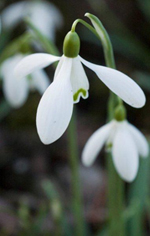There can’t be a better sight to the gardener than the emergence of this simple white flower after its seasonal sleep; those crystal white petals heralding that spring is just around the corner.
The genus Galanthus belongs to the family Amaryllidaceae and it was the great botanist and taxonomist Carl Linnaeus who gave the snowdrop its scientific name in 1735. It is derived from the Greek gala meaning milk and anthos, flower.In 1753 Linnaeus named the first species, nivalis, meaning “of the snow”. Today the genus comprises of 20 species and over 500 cultivars. With it being a native of central Europe, spreading across to Turkey and Russia, the diverse range of climates it grows in means that the main flowering window can stretch from November through to April, although the more common time is February.
Even though the snowdrop is common in our gardens and naturalised in large drifts in our woodlands, it isn’t really known who first introduced them into Britain. Most “Galanthophiles’’ tend to think that it was the Romans, or the early nomadic monks, as the snowdrop has had a long association with the church as it used to be used to celebrate the Feast of Candlemas on 2 February. However it was not until the 1850’s when soldiers returning from the Crimean War in the Caucasus, brought them back and planted them in the churchyards to remember the dead that their popularity began to grow.
So much so that last year on 16 February the world’s most expensive snowdrop bulb was purchased at auction for £725. The single bulb was G. woronowii “Elizabeth Harrison’’ which has a golden yellow ovary and petal markings. The previous record price was £226 set in 2010 for G. ‘Green Tear’.

